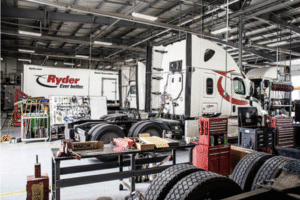After a brief slowdown due to severe weather in February, freight levels roared back in March and are expected to continue climbing in the coming months.
The American Trucking Associations’ (ATA) For-Hire Truck Tonnage Index was the outlier, falling by 5.1% in March after a 2.3% decline in the prior month. However, the freight mix for carrier members of the ATA leans toward contract loads for the manufacturing sector, the one segment of the economy that is recovering more slowly than the rest.
For months, economists have warned of shortages of parts and materials, because manufacturers are limited by supplies available from their suppliers, who often rely on suppliers of their own. Microchips are a prime example of a product in very short supply. When manufacturing slows, shipments of manufactured products also slows.
“March’s drop comes as somewhat of a surprise,” said Bob Costello, chief economist for ATA. “That said, this surprise to the downside does not change my positive outlook going forward.”
The March ATA results were particularly disappointing because the final month of each quarter of the year is typically strong as publicly held corporations position for their upcoming quarterly financial reports. Final-month spending or selling can adjust inventory and profit numbers for the quarter.
Compared with March 2020, the March 2021 Index of 106.8 represented a decline of 9.5%. As more data is submitted by ATA members, the index is often revised upwards. That could happen to the March numbers as well.
Costello spoke of what’s to come. “Household spending power is strong, and I believe there is plenty of pent-up demand for consumer spending,” he said. “Single-family home construction and stronger manufacturing output, even with the supply chain issues, will help support tonnage through this year and beyond.”
Other tonnage reports were more positive. ACT Research’s Trucking Supply-Demand Balance Index rose to 68.2 in March. In the ACT Index, anything above 50 indicates more available freight than truck capacity to haul it. The index rose 8.1 points over February and has been in positive territory for 10 consecutive months.
One of the reasons capacity remains tight is that the number of available drivers continues to fall. ACT’s Driver Availability Index fell to 16.7, reaching a new low point for the fourth consecutive month. Any number lower than 50 indicates a deteriorating condition.
Tim Denoyer, vice president and senior analyst at ACT, cautioned that the economic recovery could be impacted.
“In addition to the raft of constraints on driver capacity, from demographics to unemployment benefits to the FMCSA Drug & Alcohol Clearinghouse, constrained Class 8 production and tight vehicle inventories are also likely to limit the pace of recovery this year,” he said.
The Cass Freight Index for Shipments, which represents freight volumes in multiple modes of transportation such as trucking, rail, ship, barge, pipeline and air, rose by 5.8% over February numbers and topped March 2020 numbers by 10.0%.
ACT’s Denoyer, who wrote the text for the Cass Info release, noted that the shipments index was just 0.1% below the March 2019 pre-pandemic level, indicating that shipping volumes have fully recovered. There’s more to come, however.
“If the Cass shipments index just takes a normal seasonal pattern from here, it will be up over 30% year over year in Q2,” Denoyer wrote.
As shipment volumes continue growing faster than the trucking industry’s available capacity, truckers continue to benefit from higher rates. That’s a condition that is expected to continue for at least the rest of 2021.
The Cass Truckload Linehaul Index, which includes both rates and capacity, was 2.0% higher in March and 10.1% higher than in March 2020.
Truckstop.com, a provider of load board and other services, is reporting record spot rates from postings on the site.
“We are in an unprecedented market,” said Brent Hutto, Truckstop.com’s chief relationship officer. “Rates have never been this high for this long — ever.”
Hutto is bullish on rates for the near future. “We see rates remaining super-strong throughout 2021 and an overall increase of 2% to 3% for 2022,” he said. “We’ve never had an entire country, an entire world, coming out of a pandemic-induced recession like we’re seeing now.”
Kenny Vieth, president and senior analyst at ACT Research, wrote in an April 28 press release about ACT’s Commercial Vehicle Dealer Digest: “Combining record levels of freight demand with the constrained ability to bring supply to bear, carrier profitability is projected to rise to record levels in the coming quarters,” adding that profitable carriers typically invest in new equipment.
Don Ake, commercial vehicle equipment expert for FTR, addressed the unique character of the current economic recovery in an April 30 blog posting in which he described the country’s mood as “euphoric.” Ake pointed out that, in most recessions, inventories build as manufacturers continue production, stockpiling products to sell when the economy reopens. The latest recession, however, was different.
“The economic shutdown in March-May 2020 created enormous pent-up demand in the economy,” Ake wrote. “It produced a ‘slingshot effect,’ where commercial activity was held back and then propelled forward rapidly. Therefore, substantial pent-up demand built up during the economic lockdown and was unleashed in the restart.”
In this case, there wasn’t a “pent-up supply” available when commercial activity resumed, because so many manufacturers had slowed production or shut down entirely.
Ake refers to the Institute for Supply Management (ISM) Indexes, which reported the highest manufacturing index in 37 years for the month of March.
“The result is surging demand combined with pent-up demand, matched up against constricted supply,” Ake explained.
FTR is forecasting 2021 GDP growth of 6.1%. The U.S. Bureau of Economic Analysis reported an annualized GDP of 6.4% for the first quarter.
With an economy that’s roaring back, plenty of stimulus dollars being spent, and spot freight rates at record levels, 2021 is poised to be a great year for trucking. Shortages of both new trucks and drivers may limit profit amounts, but there is money to be made in the coming months.
Cliff Abbott is an experienced commercial vehicle driver and owner-operator who still holds a CDL in his home state of Alabama. In nearly 40 years in trucking, he’s been an instructor and trainer and has managed safety and recruiting operations for several carriers. Having never lost his love of the road, Cliff has written a book and hundreds of songs and has been writing for The Trucker for more than a decade.















